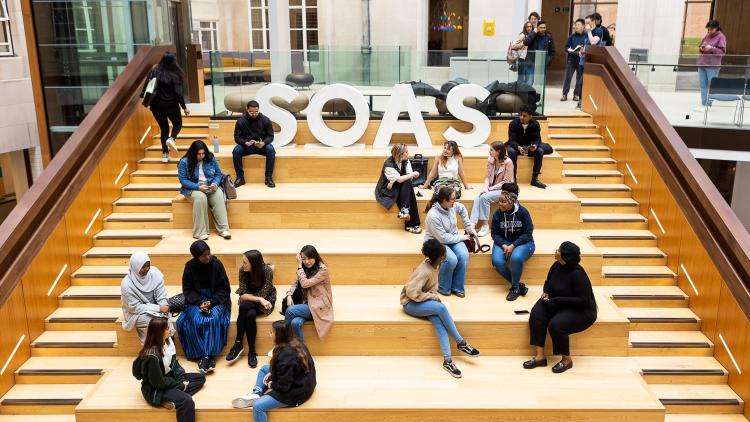Getting into university: Three things I wish I'd known before Clearing


As Sinem nears the end of her undergraduate studies at SOAS, she reflects on her unexpected journey through UCAS Clearing and shares tips to help others navigate the process with confidence.
As I reach the end of my undergraduate studies at SOAS, I have had some time to reflect on my time here—particularly how I got into SOAS in the first place. Three years ago, I was not able to sit my A Level exams due to COVID-19 restrictions. Consequently, students like myself were given “Centre Assessment Grades” by teachers; I was given lower grades than I anticipated, so I missed out on both of my offers and thus applied to UCAS Clearing.
The simplicity of the whole Clearing process surprised me. I called the SOAS Clearing line, shared my details and grades, and a few days later, I received an email confirming my place. However, I was not entirely sure what to expect or do as it simply was not discussed enough. This article aims to demystify Clearing and share three top tips on how to prepare and easily apply to Clearing efficiently.
But…what is UCAS Clearing?
If you haven’t heard of UCAS Clearing before, fret not! Clearing matches applicants to university courses that are yet to be filled. From 5 July – 17 October, you can apply for a course via UCAS Clearing if you are not holding an offer and the course has places available. As set out by UCAS, you can use Clearing if:
- You are applying after 30 June
- You do not hold any offers – either you did not receive or want to accept any offers
- You did not meet the conditions of your offers
- You have paid the multiple choice application fee of £27
- You have declined your firm place using the ‘decline my place’ button in your application
The remainder of this article will share three things I wish I had known before applying to UCAS Clearing.
1. Plan ahead
As Clearing opens before A Level Results Day, you can start researching the courses available early on if you do not hold any offers or predict that you may be using Clearing. Most universities will have a limited number of spaces that will get filled very quickly, so having a clear idea of some options will help to make the whole process go smoothly on the day. As part of your preparation, noting down your preferences alongside universities’ Clearing hotlines - which can usually be found on their own websites or the UCAS website – will help you feel prepared and calm on the day.
To understand whether a university or course is for you, it is always recommended to visit the university in person to get a feel of what it’s like. However, this may be a bit difficult to arrange for personal or logistical reasons, but you can always contact the university to see if alternative arrangements can be organised. SOAS, for example, offer a virtual campus experience, which enables prospective students to explore our campus and get a feel for where they could be studying and socialising. If you want first-hand experience from current undergraduates, many universities - including SOAS - offer a function on their websites to message current students from a diversity of academic and personal backgrounds. Additionally, you can take a look at your preferred university’s social media, blog, and website for further information.
2. Pen and paper will be your best friend(s)
Before the ‘big day’, it is important to have all key information at hand. These include:
- A list of Clearing hotlines of universities that both have places and are of interest to you
- Your UCAS Personal ID Number
- Your A Level and GCSE grades
- Your Clearing number, which will appear on UCAS Track/Hub on Results’ Day if eligible
- Your email address. This is the main communication for any offers/further information we require
You may also want to keep a list of questions ready, asking about the availability of any scholarships or bursaries that Clearing students may be eligible for, student accommodation arrangements and how the university will support you in finding a place, and how the university may support you with any reasonable adjustments.
On the ‘big day’, ensure to take the name of the person who gives you an informal offer over the phone, and kindly ask for any emails that you can note down for any future queries. The Clearing process can be an extremely busy time for both students and Clearing staff, so a few administrative difficulties may arise. Gathering this information will allow you to easily follow up if you do not hear back from the university at all. Some unintentional mistakes may be made – so it’s vital to be proactive and chase things up to prevent your place from being taken by somebody else.
3. Remain calm and patient
You may have read the subtitle above and rolled your eyes… I know! It can be irritating to hear it, but taking care of yourself must always be your priority, particularly during a busy period such as Clearing. Staying optimistic is equally crucial – some universities participating in Clearing may be willing to accept you even if you don’t meet their Clearing entry requirements. You only ever regret the chances you do not take in life, so dial the hotline with confidence and try your luck.
UCAS Clearing can sometimes be stigmatised as some may view it as a last resort, leaving students feeling as though they have ‘failed’ - but it's absolutely not the case! If you have not quite received the grades that you anticipated on Results’ Day or have simply changed your mind, it is important to actively frame and welcome this as a change in trajectory, as opposed to viewing it as a failure. It is easier said than done, however remember that your grades do not define who you are. You are the constant in this 'equation of life' - no matter where you go or which degree you pursue, it will always be up to you to make the most of the opportunities that come your way!
About the author
Sinem Ishlek is a SOAS Digital Ambassador, currently pursuing an undergraduate degree in Global Development. Her main interests include Human Rights Law and Public Policy






